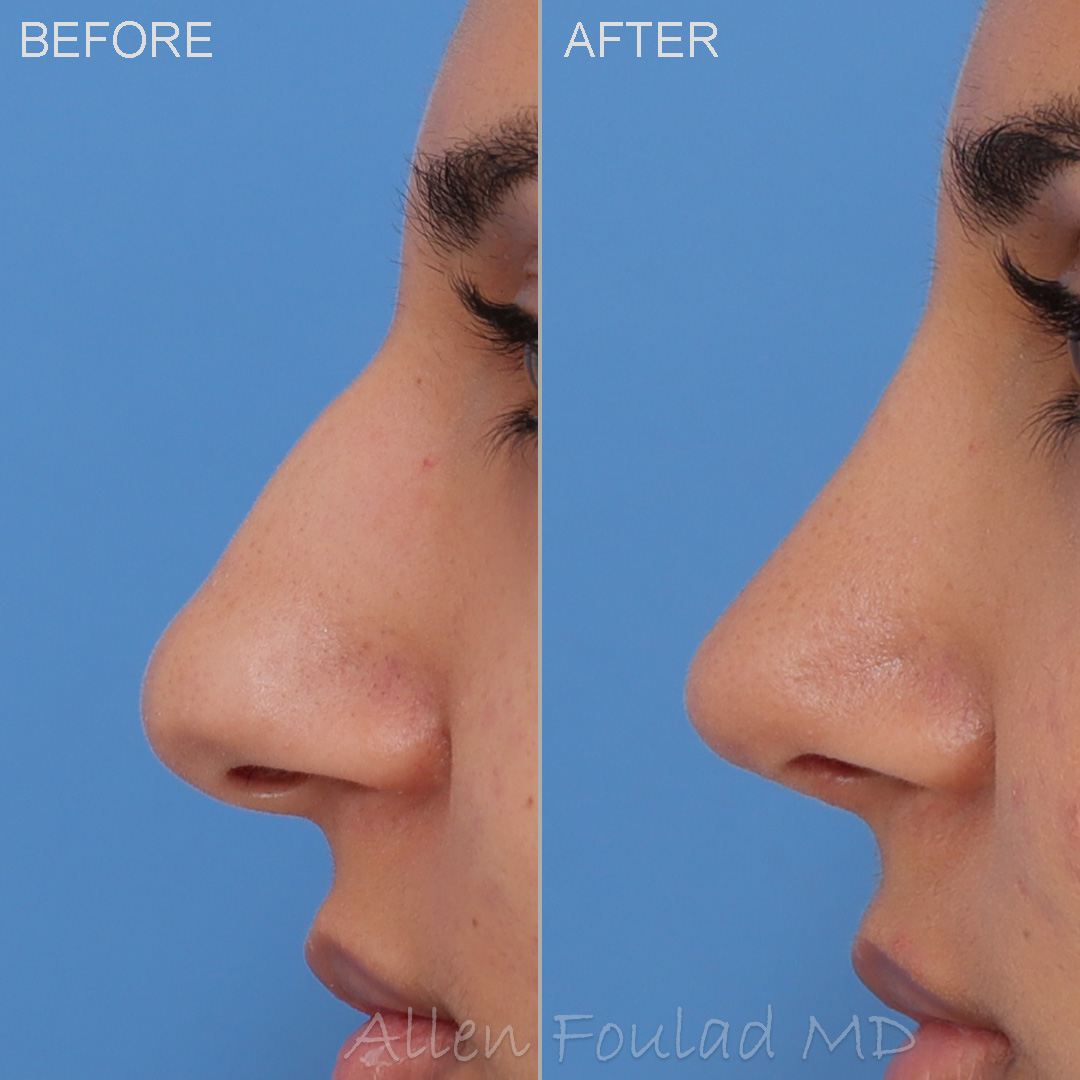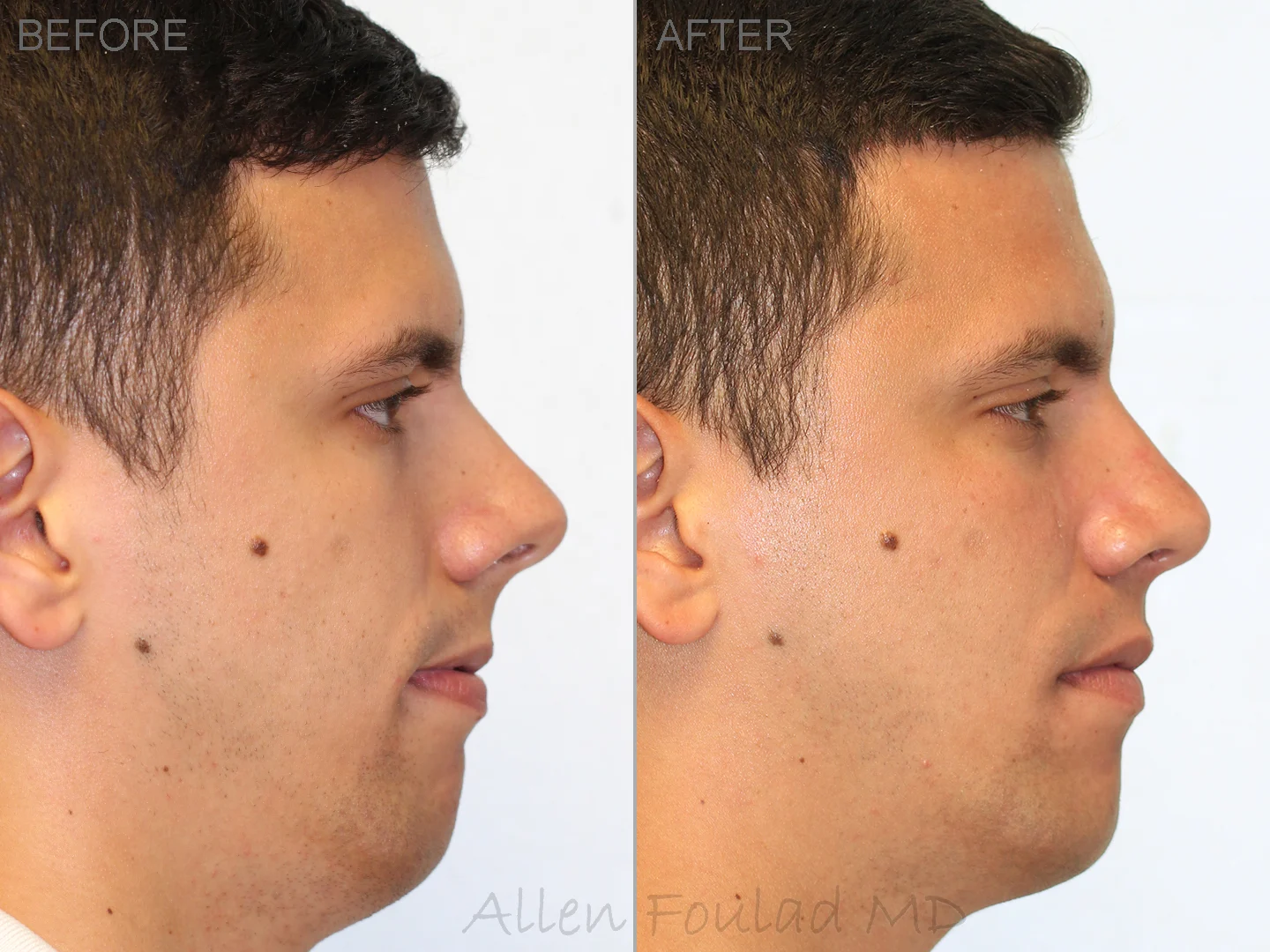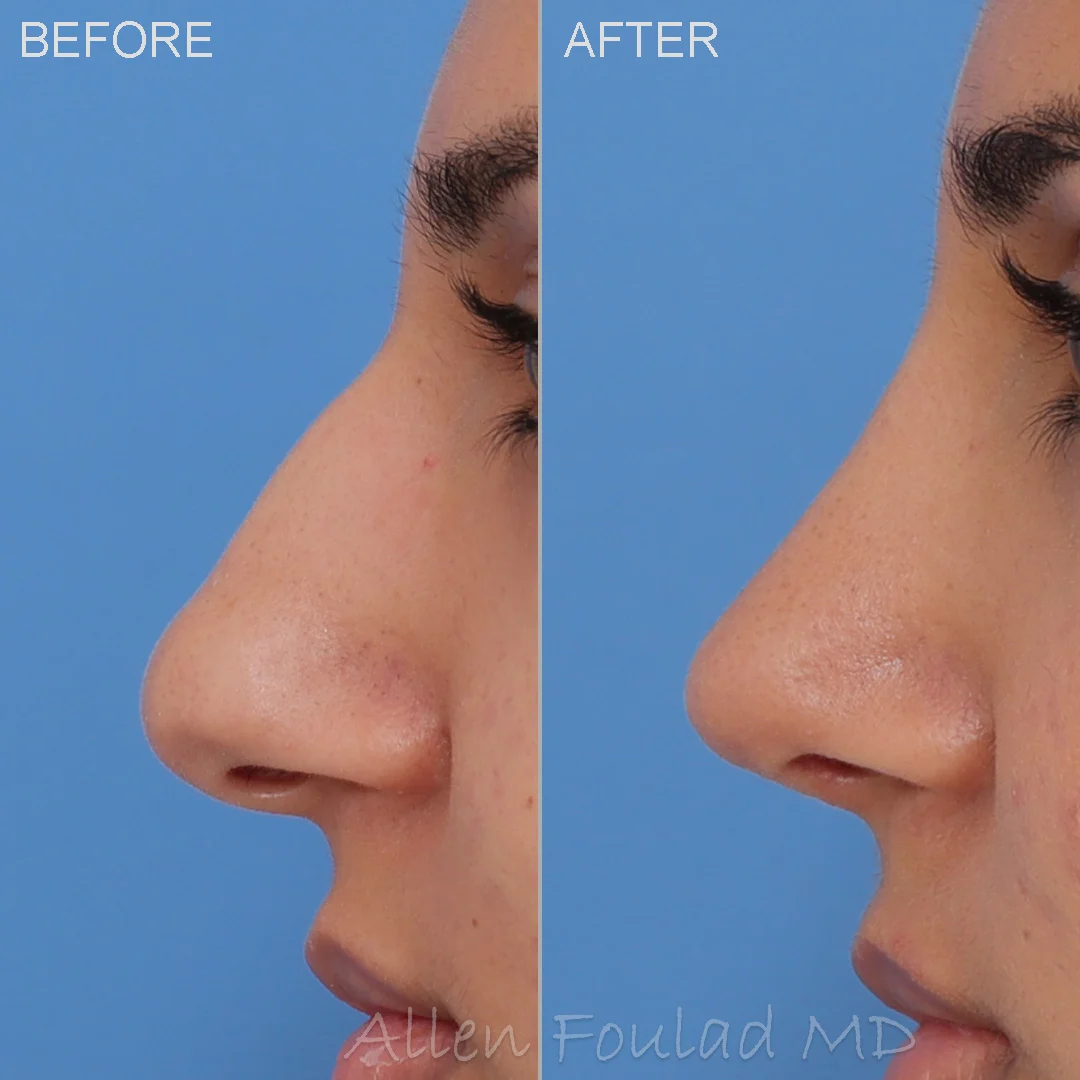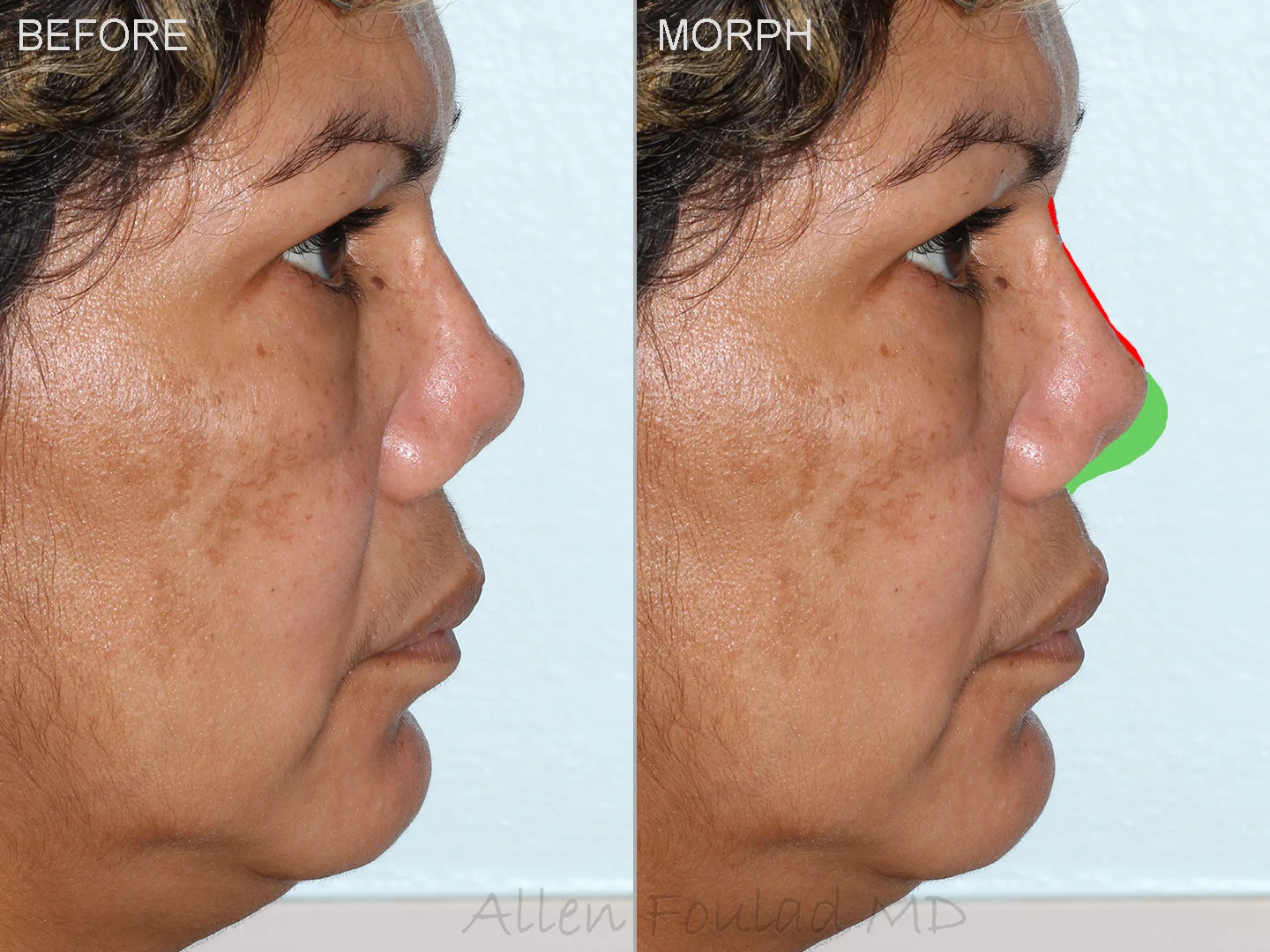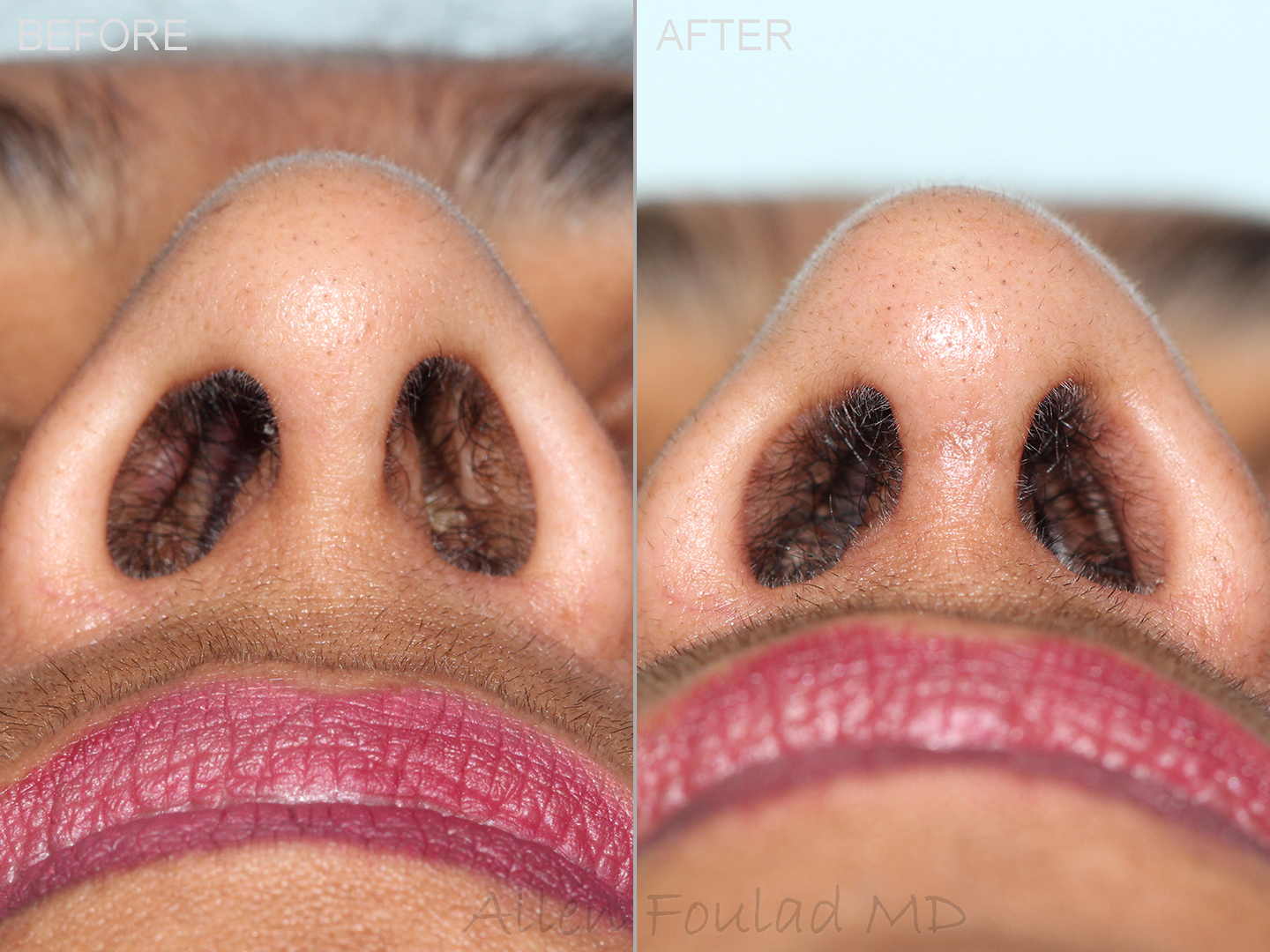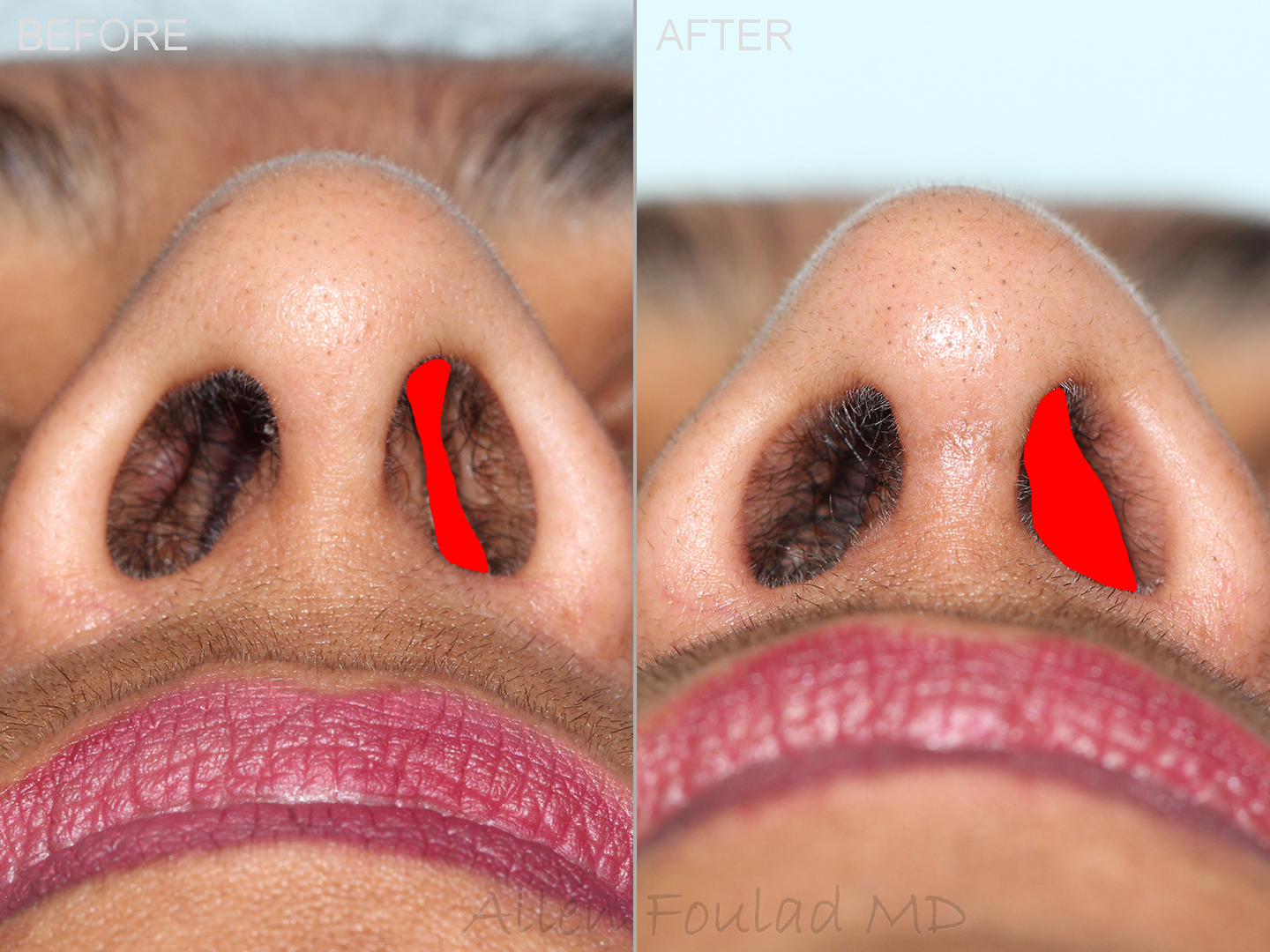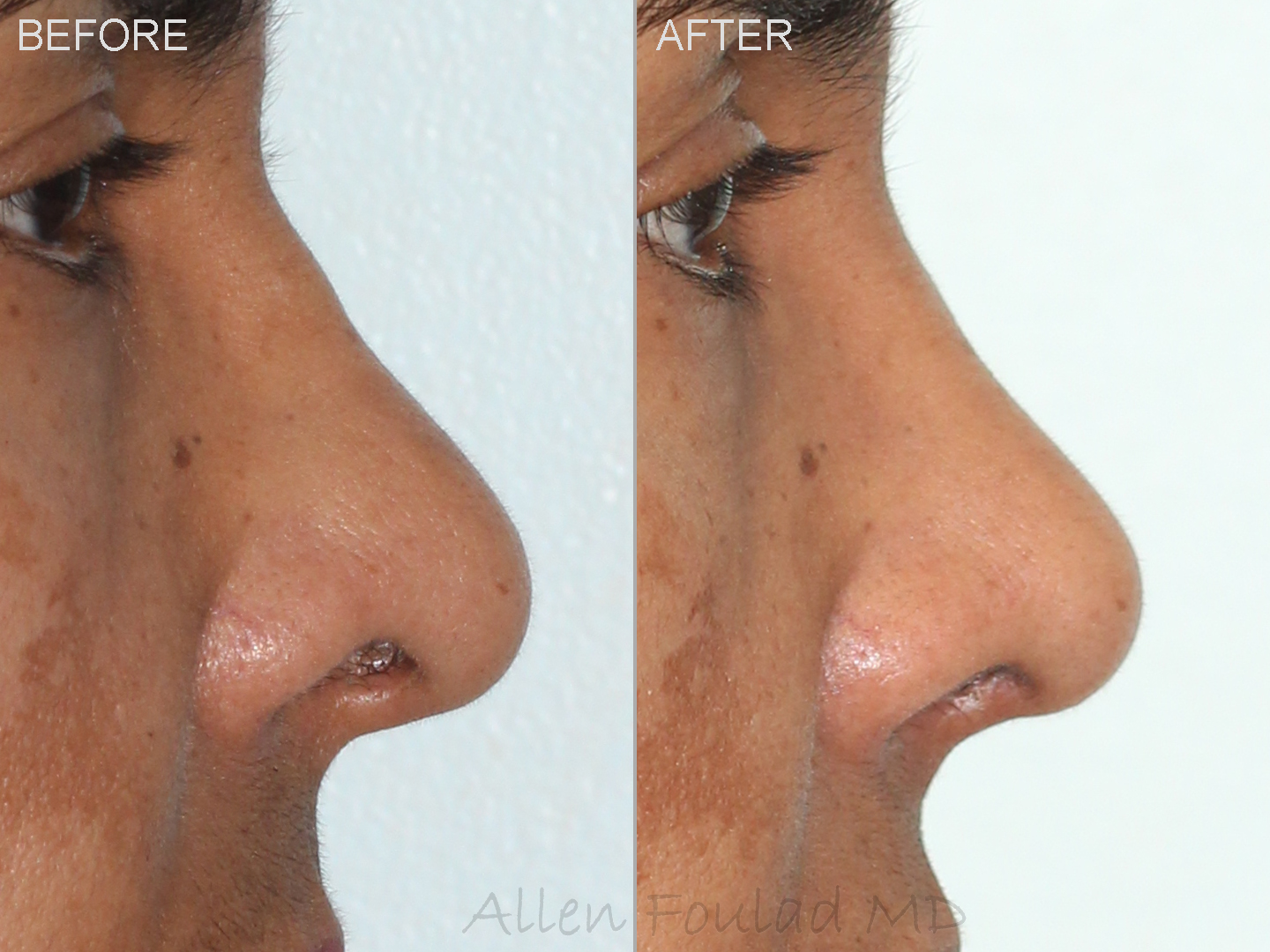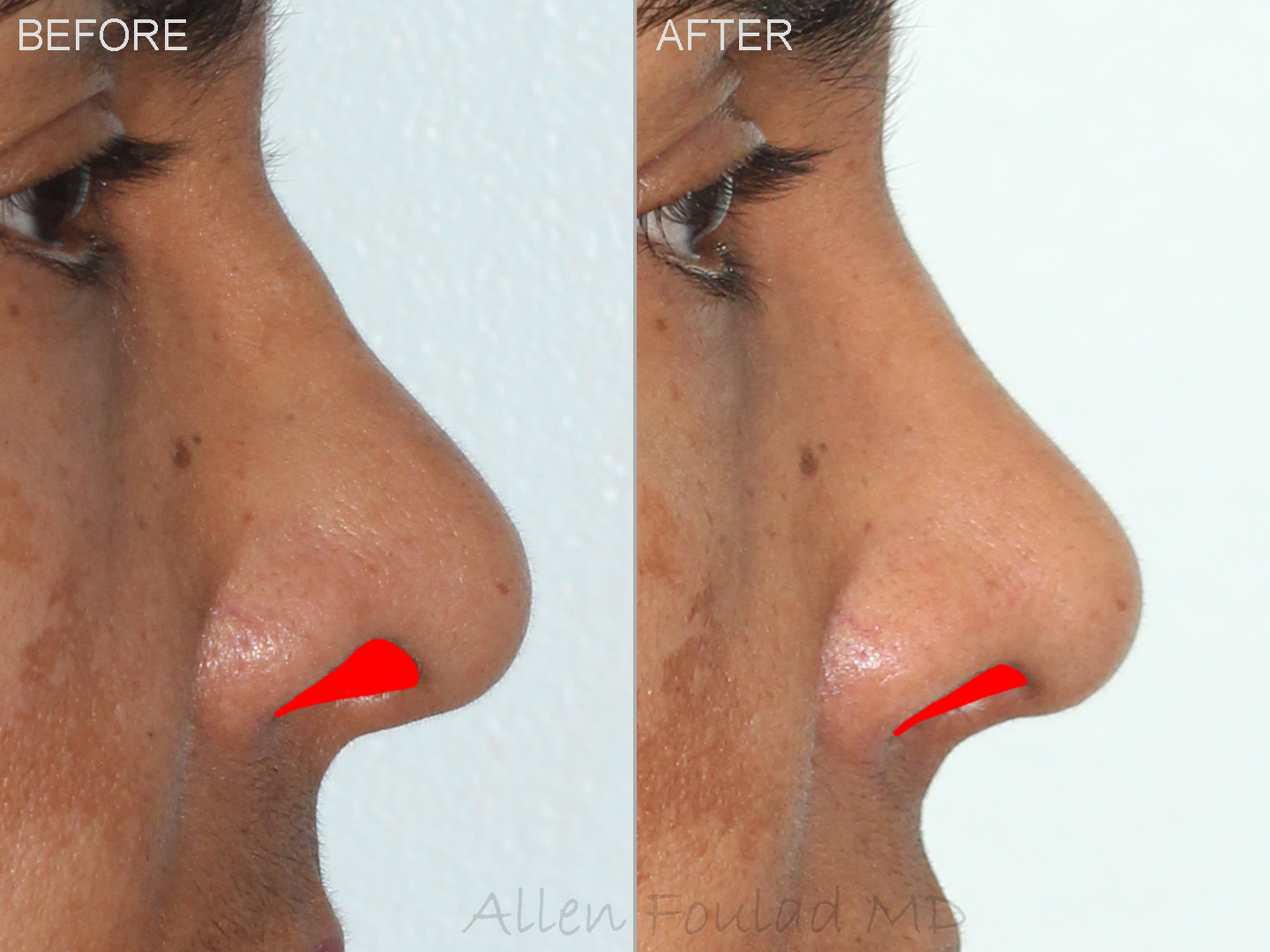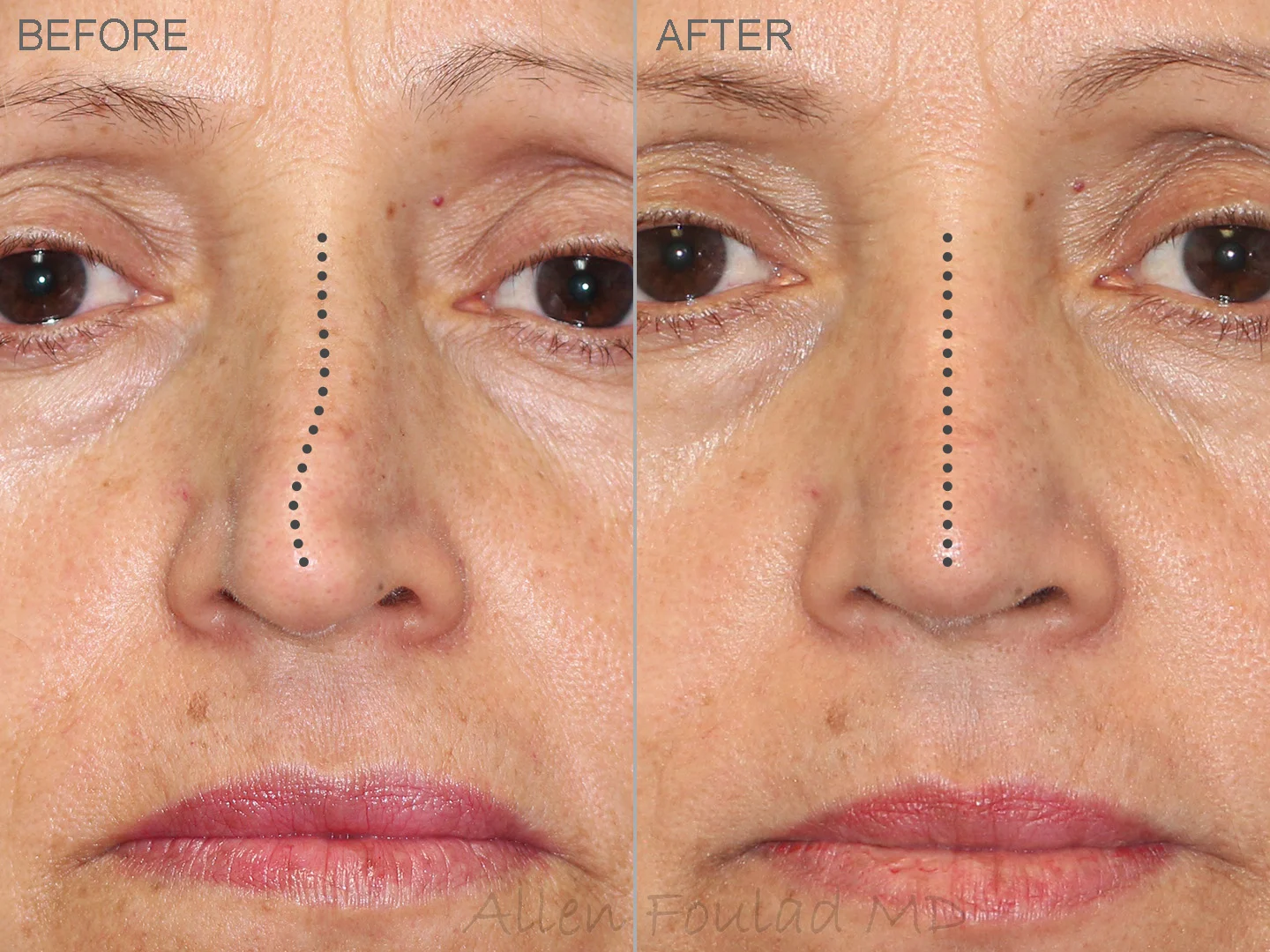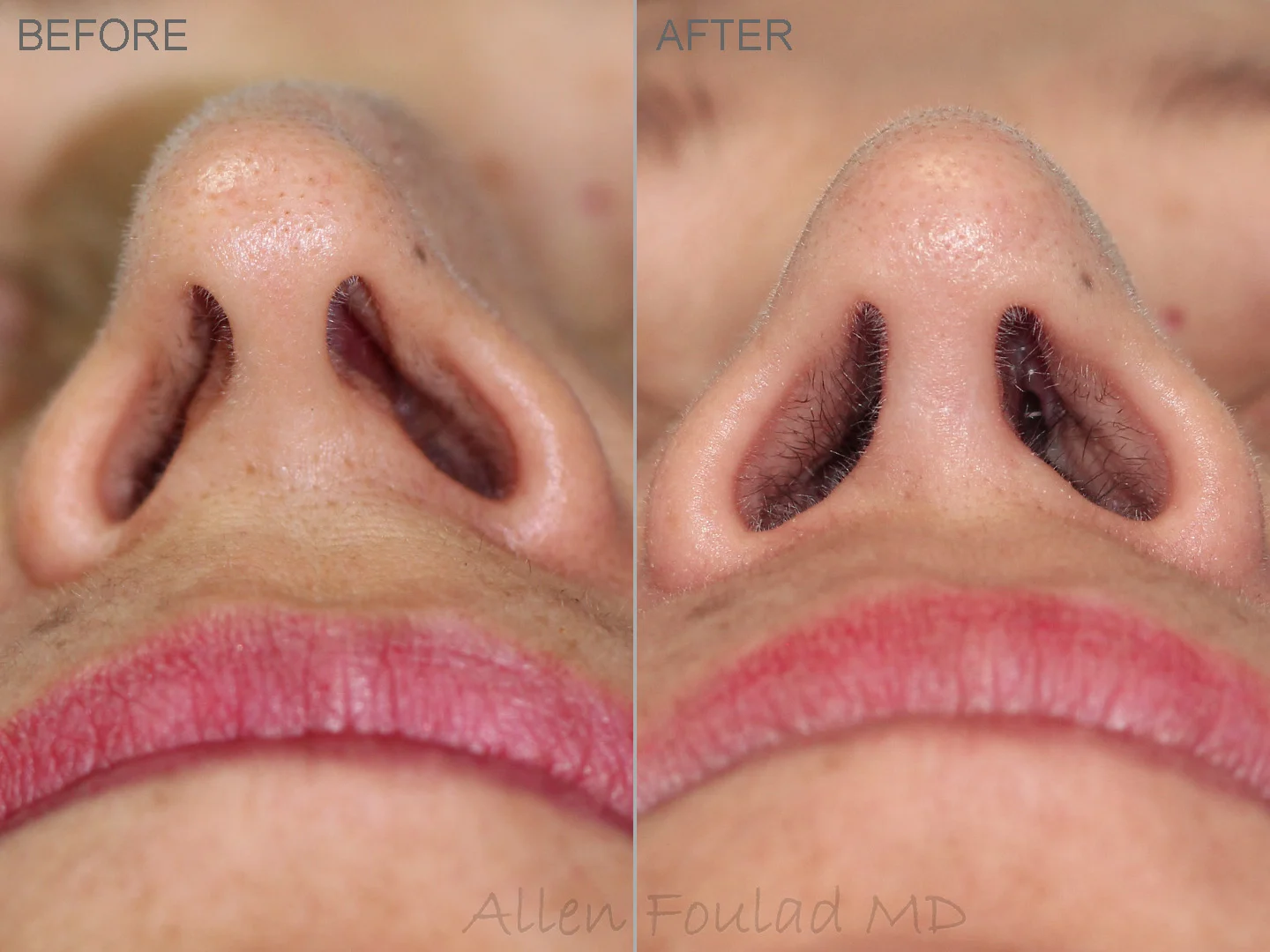Beverly Hills, CA facial plastic surgeon, Dr. Allen Foulad, offers expert rhinoplasty procedures tailored to meet your unique aesthetic goals. With extensive experience and a meticulous approach, Dr. Foulad delivers natural-looking results that complement your facial features. Whether you are looking to refine the shape of your nose, correct a deviated septum, or repair previous nasal injuries or surgeries, our personalized care ensures your satisfaction. Discover the transformative benefits of rhinoplasty with one of Beverly Hills’ leading facial plastic surgeons.
Candidates for Rhinoplasty
Candidates for rhinoplasty, commonly known as a nose job, can include individuals with either functional issues or aesthetic concerns, or both. Ideal candidates include:
Healthy Individuals- Candidates should be in good overall health, with no serious medical conditions that could impair healing or increase surgical risks.
Nasal Concerns- Individuals seeking to improve the shape, size, or proportion of their nose, or those needing correction for a deviated septum, nasal asymmetry, or breathing difficulties.
Age Considerations- Candidates should have fully developed facial features. This means girls should be at least 15-16 years old, and boys around 17-18 years old.
Realistic Expectations- It is important for candidates to have realistic expectations about the outcomes of the surgery.
Candidates for Septoplasty
In patients with nasal obstruction, a septoplasty may be indicated if there is deviation of the septum. The septum is the structure that separates the left nostril and right nostril. Straightening a crooked septum not only improves breathing through the nose but can also potentially help with snoring and sleep apnea. Another cause for nasal obstruction is large turbinates (e.g., inferior turbinate hypertrophy). The turbinates are structures inside the nose that warm and moisturize air. If these structures are abnormally large and are causing obstruction, a turbinate reduction can be helpful.
The Importance of a Rhinoplasty Expert
Rhinoplasty is one of the most challenging procedures in plastic surgery. The difference of even a single millimeter can significantly affect the appearance and functionality of the nose. Furthermore, some changes after a rhinoplasty may not become evident for months or years later. Scar tissue formation, contracture, and collapse can progressively worsen with time.
Dr. Foulad performs revision rhinoplasty following a primary rhinoplasty that did not turn out well, either because of poor cosmetic outcome and/or difficulty with breathing. It is imperative that your rhinoplasty is performed by a well-trained surgeon who recognizes the complexities of the nose. The techniques performed should be customized for each patient, while considering the effects on both appearance and breathing.
How Rhinoplasty is Performed
Dr. Foulad commonly performs rhinoplasty using twilight sedation, ensuring patient comfort and safety throughout the procedure. He frequently employs the external (open) approach, which allows for excellent visualization and access to all nasal structures. The small incision made at the base of the nose heals well and is typically unnoticeable when sutured meticulously.
During the rhinoplasty, Dr. Foulad focuses on maintaining the strength and integrity of the nasal structures, such as the cartilage. Various cartilage grafts are often used to provide additional support to the nose and nasal tip. These grafts are strategically placed to enhance the nose’s structure without adding unnecessary bulk, achieving a balanced and natural-looking result.
How to Prepare for Rhinoplasty
Preparing for rhinoplasty involves several important steps to ensure you are in optimal health for the procedure and to minimize any risks. First, it is crucial to maintain good overall health and follow any specific guidelines provided by your surgeon. Certain medications and supplements may need to be discontinued a few weeks before the surgery to reduce the risk of bleeding and other complications. Additionally, you must avoid smoking or using nicotine products for at least 1-2 months before and after the procedure, as nicotine can impair healing and increase the risk of complications. Your surgeon will provide you with detailed pre-operative instructions tailored to your individual needs, ensuring you are fully prepared for your rhinoplasty journey.
We are conveniently located to serve Beverly Hills, West Hollywood, & Los Angeles. However, we are available to help with coordinating your stay if you are an Out-of-Town Patient.
What to Expect After Rhinoplasty
After your rhinoplasty, you may have soft silicone tubes in your nose, allowing you to breathe through them instead of using traditional packing. These intranasal tubes are typically removed 3-7 days after your procedure. Additionally, a cast will be placed on the outside of your nose to support it as it heals, which is usually removed after about one week along with any sutures.
To help reduce swelling, it is recommended to sleep with your head elevated for at least one week following the procedure. If osteotomies (bone fractures) were performed, you are likely to experience bruising around your eyes, with bruising and swelling typically peaking around 3 to 4 days post-surgery.
Most patients find they are presentable in social settings 1 to 2 weeks after the procedure. However, it is important to note that while much of the swelling subsides within the first few months, it can take up to a full year to see the fuller results. The nose may continue to undergo subtle changes even beyond that time.
For more detailed guidance in ensuring the results of your rhinoplasty, access our post-operative care instructions.
Schedule Your Rhinoplasty Consultation with Dr. Foulad
Schedule your rhinoplasty consultation at our Beverly Hills offices within the prestigious Lasky Clinic. Enjoy the highest level of confidentiality and quality care with procedures performed in state-of-the-art, accredited operating rooms on-premises, and supported by a team of highly experienced surgical staff and board-certified anesthesiologists.
For out-of-town patients, we offer convenient virtual video consultations, and our office is easily accessible from Los Angeles International Airport (LAX) and Burbank Airport (BUR). With a selection of nearby luxury hotels. Contact us today at Allen Foulad MD, Facial Plastic Surgery to arrange your appointment.
Rhinoplasty
Before and After Gallery
Rhinoplasty faq
Will I Be Able to Breathe Through My Nose After Rhinoplasty?
Instead of the traditional packing, Dr. Foulad uses soft silicone tubes so that you can breathe through your nose. The tubes are typically removed 3 to 7 days after the procedure.
How Much Does Rhinoplasty Cost?
The cost of rhinoplasty varies significantly due to the customized nature of the procedure, with factors such as the complexity of the surgery and the specific goals influencing the final price. During your consultation with Dr. Foulad, you will receive a detailed surgical plan tailored to your unique needs, along with a precise pricing estimate.
To make the procedure more accessible, we offer flexible payment plans through CareCredit, allowing you to finance your treatment with easy monthly payments.
What Are the Risks and Complications of Rhinoplasty?
Rhinoplasty carries potential risks, including infection, bleeding, and adverse reactions to anesthesia. Other complications may involve scarring, difficulty breathing, and unsatisfactory aesthetic results that might require revision surgery.
What Is the Difference Between Rhinoplasty and Septoplasty?
Rhinoplasty can help improve breathing, but typically also enhances the appearance of the nose, addressing cosmetic concerns like shape, size, and symmetry. Septoplasty, on the other hand, does not typically alter the shape of the nose if performed alone, and is aimed at correcting a deviated septum to improve nasal function and breathing.
How Long Will My Rhinoplasty Results Last?
Rhinoplasty results are long-lasting, often lasting a lifetime. However, the nose may experience subtle changes due to aging and other factors, but the improvements made by the surgery typically remain.
Associated Resources
Case samples
Case 1: Rhinoplasty
Primary Rhinoplasty • Septoplasty
View case Details ▼
The case presented in this section involves a gentleman who presented with concern of nasal obstruction and an over-rotated (upturned) nose. The over-rotation of his nose was associated with excess nostril exposure and tenting of his upper lip.
I performed a rhinoplasty with septoplasty to treat his nasal obstruction and to improve the appearance of his nose. From a cosmetic standpoint, a major goal was to decrease the rotation and projection of the tip of his nose. In order to precisely set the tip at the appropriate position, a caudal septal extension graft was used. This graft was created using cartilage from his septum that had been harvested during the septoplasty. The caudal septal extension graft is placed to support and position the tip, and help prevent the tip from moving over time. The height of the bridge of the nose (dorsum) was also reduced to match the new height of the tip. This was performed very meticulously to maintain his original straight dorsal profile. Attention was also placed on improving the contour at the junction of the lip and nose. In order to accomplish this, the skin at the bottom of the nose (columella) was recruited downwards, creating a more refined lip-nose junction. This also reduced the pull on the upper lip, which improved closure of his lips. The combination of all these techniques and attention to minor details resulted in substantial overall refinement and a natural appearance.
Case 2: Rhinoplasty
Primary Rhinoplasty • Septoplasty
View case Details ▼
The case presented in this section involves a female who desired to reduce the size and hump of her nose. She also had a deviated septum, which was causing nasal congestion.
I performed a rhinoplasty and septoplasty to enhance the appearance of her nose and improve her breathing. Rasping of the nasal bones was performed to reduce the hump and straighten the bridge of the nose. A caudal septal extension graft was performed to precisely support the nasal tip in the desired position. This cartilage graft was obtained from the septum during the septoplasty. A lateral crural turn-in flap, interdomal suture, and alar-spanning suture were performed to refine the nasal tip. These structural tip narrowing techniques maintain much greater support, unlike traditional reduction techniques that rely the removal of cartilage. By maintaining a strong structural framework, the risk of nasal collapse and deformity is significantly reduced.
Case 3: Rhinoplasty
Revision Rhinoplasty • Rib Cartilage Grafts
View case Details ▼
This case involves a female who initially underwent two rhinoplasty surgeries with another surgeon. During her most recent operation, the surgeon used cartilage grafts from her ear. However, she continued to have a severe deformity of her nose and developed worsening breathing problems.
I performed revision rhinoplasty using rib cartilage to reconstruct her nose. As with all my patients, meticulous planning was performed before the procedure. Traditional morphs were created to demonstrate the anticipated appearance of the nose after the procedure, and morph ‘blueprints’ were designed to illustrate the exact changes needed. The main challenge of this case involved significant lengthening of her nose and providing appropriate structural support.
Rib cartilage was used to create various grafts in order to support and lengthen the nose. The foundation of the nose was reconstructed with a flying buttress graft. A diced cartilage fascia (DCF) graft was then placed along the dorsum of the nose to improve the dorsal profile. Rim grafts were placed to help support the nostril rim.
CASE 4: Rhinoplasty
Revision Rhinoplasty • Septoplasty
View case Details ▼
This case involves a female who underwent rhinoplasty and septoplasty by another surgeon one year prior to her consultation with me. She stated that the goal during the first surgery was to remove a hump and to improve her breathing. However, after the rhinoplasty, her breathing worsened.
On exam, the front part of the septum was deviated to the left. She also had collapse of the side of her nose. The combination of these problems resulted in a very narrow airway (refer to Base View Photographs). From a cosmetic perspective, she had poor contour of her nose and retraction of the alar rim (refer to Profile View Photographs). Alar rim retraction is a condition in which the nostril rim is elevated (pulled upward), which leads to exaggerated nostril exposure. Alar rim retraction is a common complication of rhinoplasty and can occur because of excessive cartilage resection and/or improper cartilage positioning.
I performed a revision rhinoplasty and septoplasty in order to fully straighten the deviated septum, treat the collapse and retraction, and to improve the contour of her nose.
The front part of the septum is a relatively difficult region of the septum to straighten and requires specialized skill to properly manage. I had to separate the septum from its attachment at the front of the nose, straighten the cartilage using various maneuvers, and then re-secure the septum in a more appropriate position. The alar retraction was corrected using articulated rim grafts created from her own cartilage. Unlike conventional rim grafts, articulated rim grafts require significantly more skill to use, but are much more effective in pulling the rim down and preventing future retraction.
Case 5: Rhinoplasty
Primary Rhinoplasty • Straightening Deviation • Septoplasty
View case Details ▼
This case involves a female who was trampled by a horse and injured her nose approximately a decade before presenting to me for rhinoplasty surgery. Her main concern was a nasal obstruction that was so severe that it forced her to breathe through her mouth. In addition to wanting to improve her breathing, she desired to straighten her nose while maintaining her natural appearance.
I performed a functional rhinoplasty with septoplasty using an external (open) approach. The external approach provides optimal visualization and access to the structures of the nose. This enables the ability to perform advanced techniques that are not otherwise possible using a closed (endonasal) approach. The small incision created at the bottom of the nose for the external approach is typically imperceptible when sutured meticulously.
An important step in the case was to straighten the septum. This involved releasing a significant amount of scar tissue that had formed due to the trauma. The fractured and deviated cartilage at the center of the septum was removed, and the remainder of the cartilage was repositioned in a more straight position. A sufficient amount of cartilage was maintained at the septum to ensure adequate support of the nose. The portion of the cartilage that was removed from the septum was then used as a caudal septal extension graft in order to provide support for the tip of the nose. The remaining structural elements of the nose were then able to be aligned based on the straight and strong foundation.

